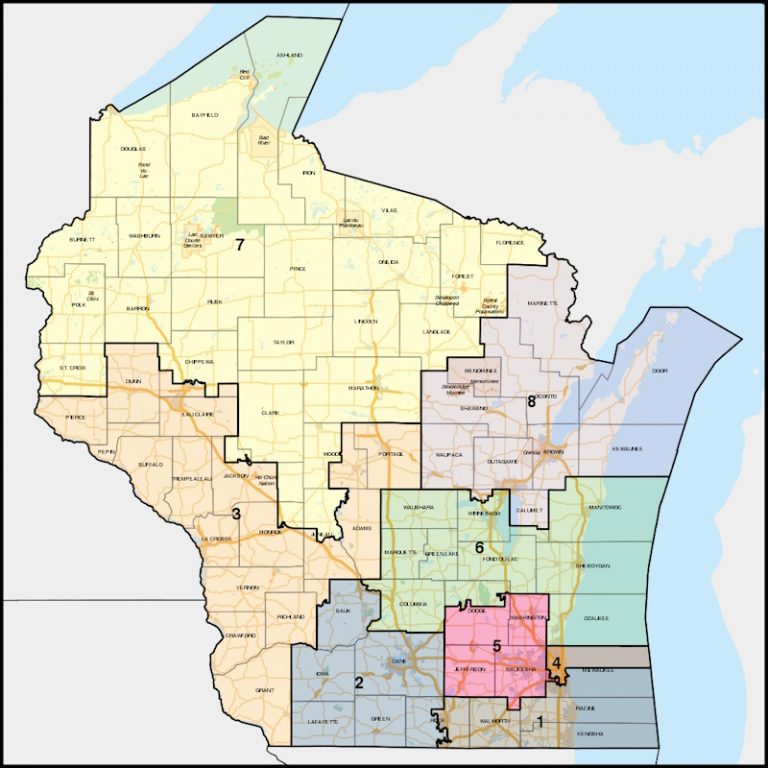State High Court Should Review Our Gerrymandered Congressional Districts
Just how gerrymandered are Wisconsin's districts? Let's look at the numbers.

Wisconsin Congressional Districts, 118th Congress. Twotwofourtysix, (CC BY-SA 4.0), via Wikimedia Commons
Following the 2010 Census, Governor Scott Walker and the Republican-dominated Legislature adopted new gerrymandered Congressional, state Senate, and Assembly districts that gave an overwhelming advantage to Republicans in the control of these bodies. Following the 2020 Census, the Wisconsin Supreme Court adopted a “least change” criterion for new maps, essentially voting to continue the gerrymander for another 10 years.
In August 2023, after an election gave the Wisconsin Supreme Court a liberal majority, it accepted a petition challenging the gerrymandered state Senate and Assembly maps. It ruled against these maps for violating the Wisconsin Constitution’s requirement that these districts be “contiguous.” In the process it rejected the “least change” criterion.
Notably, the current state Supreme Court did not address the Wisconsin congressional gerrymander, though it too was based on the same “least change” criterion that has now been rejected for state legislative districts. However, a suit filed in January with the high courts challenges the current congressional districts.
Just how gerrymandered are they? Given that Wisconsin is a highly competitive state, one might expect that half its eight congressional seats would favor Democrats and half Republicans. Instead, of the eight members of Congress, six are currently held by Republicans and only two by Democrats.
Based on results from six statewide Wisconsin elections, the website Dave’s Redistricting (DRA), widely used to assess proposed district maps, calculates that the inherent partisan divide among districts as shown on the chart below. The chart shows the eight districts in order of increasing share of the vote for Democratic candidates. In summary, in four of the eight districts Republican candidates have a lock. Two districts are overwhelmingly Democratic. The remaining two are competitive, but slightly favor Republicans. This means that the best Democrats can do is win four seats; the worst is two. For Republicans, the worst outcome is winning four seats with a good chance of winning six, as evidenced by the current distribution of seats.
The next graph shows one example of a map that is designed for partisan neutrality. Called “Kevin’s Wisconsin” map, it would give each party two seats enjoying a vote majority in the sixties. The remaining four seats would give each party two seats with a vote majority between 53% and 55% percent.
I chose Kevin’s Wisconsin for this comparison because DRA rated it tops for both proportionality and compactness, as shown on the next chart.
The next chart compares the two maps on four measures of proportionality. The closer to zero each of these measures is, the closer it is to proportionality. On every one of these measures, the Kevin’s map is far closer to a perfectly unbiased map than is the current map.
The lawsuit filed with the Wisconsin Supreme Court notes the current congressional maps are a product of the “least change” criterion the Court has rejected when applied to state legislative maps. So far, the Court has not responded to this challenge. Given the Wisconsin Elections Commission’s statement that districts needed to be in place by March 15 for the coming November election, the challenge is running out of time.
A letter to the Supreme Court from the Department of Justice representing Governor Evers encourages the Court to act:
Given that the maps the Governor submitted in Johnson were grounded in that “least change” approach, the Governor urges the Court to review its decision and stands ready to participate in any future proceedings the Court may order.
There is increasing evidence that democracy is under attack both at home and abroad. Getting rid of the gerrymandered Wisconsin Congressional map would be good for the future of democracy in Wisconsin.
In addition, it may have much broader implications for global democracy if it served to reduce the number of members of Congress who ally themselves with Vladimir Putin over the Russian invasion of Ukraine.
If you think stories like this are important, become a member of Urban Milwaukee and help support real, independent journalism. Plus you get some cool added benefits.
Data Wonk
-
The Imperial Legislature Is Shot Down
 Jul 10th, 2024 by Bruce Thompson
Jul 10th, 2024 by Bruce Thompson
-
Counting the Lies By Trump
 Jul 3rd, 2024 by Bruce Thompson
Jul 3rd, 2024 by Bruce Thompson
-
How Did Politics Affect Covid Deaths?
 Jun 26th, 2024 by Bruce Thompson
Jun 26th, 2024 by Bruce Thompson

























Something is wrong with the top 2 charts; it shows the 2nd and 5th districts being overwhelmingly Democratic, but that should be the 2nd and the 4th. The 5th district is Scott Fitzgerald’s district and he’s no Democrat.